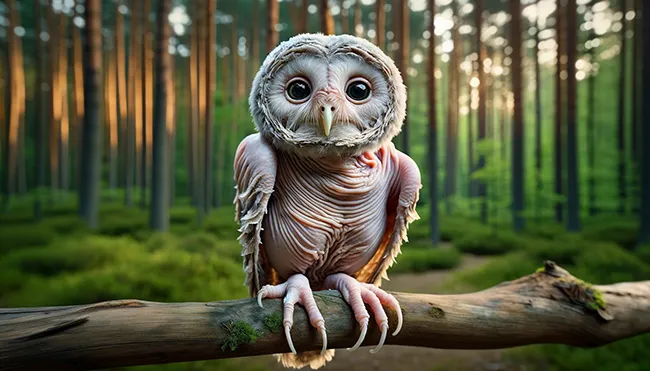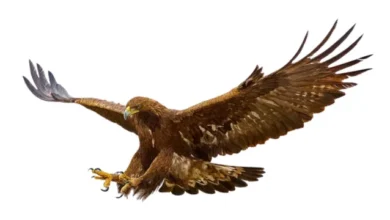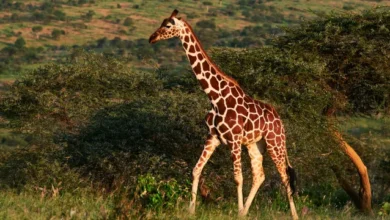
Featherless Owls! For owls, feathers are not just a beautiful feature; they fulfill many vital roles that are necessary for their survival. This thorough investigation explores the importance of feathers for owls, the effects of losing them, and the routes to healing and rehabilitation.
Owls captivate us with their silent flight, haunting calls, and mesmerizing eyes. Nonetheless, their feathers are essential to their survival. In addition to helping with flight and insulation, feathers also serve as camouflage and weather protection. But what happens when an owl loses these vital features? The phenomenon reveals a clear image and provides insight into the challenges these majestic birds encounter without their feathers.
The Essential Role of Feathers in Owl Survival-Featherless Owls!
Feathers play a fundamental role in the survival of owls, far beyond what one might consider at first glance. Let’s delve deeper into each aspect to understand their importance:
Insulation and Temperature Regulation
Featherless Owls! Owls and other birds do not have sweat glands, which are very important for mammals because they help keep the body cool by sweating. Instead, owls depend on their feathers to do this important job. The feathers naturally keep the air close to their bodies, keeping them warm. This layer of trapped air keeps the owl warm when it is cold outside by stopping its body heat from leaving. In warmer places, on the other hand, the feathers help reflect sunlight and let air flow, which keeps the owl from getting too hot. Owls need to be able to control their body temperature in order to stay alive, which lets them live in a lot of different places, from cold northern woods to warmer areas. Regardless of the weather, owls can keep a safe body temperature because their feathers add insulation.
Flight and Hunting Efficiency
Featherless Owls! The way an owl’s wings are shaped is a miracle of evolution; they were designed to help them hunt better. There are sharp points on the leading edge of the main feathers, which are the big feathers at the tip of the wing. The unique shape of this part breaks up the flow of air over the wing’s surface, which lowers turbulence and, in turn, the noise made during flight. Owls must possess the ability to fly silently in order to approach their prey without detection. They are better at getting food because they are quiet when they come close, giving their prey little time to prepare. Owls would lose this advantage without their feathers, which would make it much harder for them to catch food. This would make it harder for them to eat, which could lead to them going hungry.
Camouflage and Protection
The feathers on owls also help them hide so they can fit in with their surroundings without standing out. This camouflage is very important for both hunting and keeping the owl safe from attackers. Predators can not find owls because they fit in with their surroundings. This lowers their chances of being eaten. In the same way, this disguise helps owls hunt by hiding them from their prey until it is too late. Owls’ feathers often have patterns and colors that look like the things they live in, like the bark of trees in the forest or the colors of the desert. This helps them hide in the wild, where they are more likely to survive.
Causes of Feather Loss in Owls-Featherless Owls!
Losing feathers can make it much harder for owls to stay alive and do well in the wild. There are many things that can cause this loss, and each one presents its own problems for the owl. Here is a thorough look at the main reasons why feathers fall out:
Diseases and Parasites
Owls can fall victim to a range of avian diseases and parasites, which can lead to significant feather loss. One notable disease is Psittacine Beak and Feather Disease (PBFD), a viral infection that affects the feathers, beak, and nails of birds. This disease can cause feathers to become brittle, change color, and eventually fall out. Similarly, parasites such as feather mites live on the bird, feeding on its feathers and skin, which can lead to itching, irritation, and subsequent feather loss. These conditions do more than just alter the owl’s appearance; they can severely impact the bird’s overall health, making it more susceptible to other diseases and reducing its ability to regulate its body temperature, fly, and hunt.
Nutritional Deficiencies
Just like in humans, proper nutrition is essential for owls to maintain healthy feathers. A diet lacking in essential nutrients, particularly certain vitamins and minerals, can lead to feather deterioration and loss. For example, a deficiency in vitamin A can lead to poor feather quality, while a lack of certain amino acids, which are the building blocks of proteins, can result in weak feathers that are more prone to falling out. Since feathers are made up of keratin, a protein, an adequate protein intake is crucial for feather development and maintenance.
Stress and Environmental Factors
The health of owl feathers is affected by things in the environment that cause stress. Loss of habitat, pollution, and climate change can make the environment stressful for owls, which can damage their feathers. The worry that comes from things like changes in the environment losing a habitat, or being bothered by people can cause something called stress molting. Unlike normal molting, stress molting can cause feathers to fall out too quickly and unevenly, leaving the owl open to changes in temperature and predators. The owl’s state not only hurts its physical health, but it can also hurt its mental health, making things even worse.
Molting
Owls naturally need to molt, which is the process by which they replace feathers that are worn out or destroyed. Birds usually molt once a year, which is a sign that they are healthy. But molting that happens too much or at strange times can be a sign of deeper health problems. Abnormal molting could be caused by any of the things listed above (diseases, nutritional deficits, or stress), or it could be a sign of other health problems that are not obvious at first glance. Even though molting is a normal part of an owl’s life, keeping an eye on it can tell you a lot about the bird’s health.
Health and Survival Implications
Feather loss in owls is not just a superficial problem; it can have profound effects on their health and chances of survival in the wild. Each feather serves a purpose, and without them, owls face several critical challenges:
Vulnerability to Extreme Temperatures
Feathers act as an insulating layer that helps owls maintain their body temperature by trapping air close to their skin. In cold environments, this trapped air is warmed by the owl’s body heat, functioning as a barrier against the cold. Conversely, in hot climates, feathers help to reflect sunlight and facilitate the dissipation of heat. Without this natural insulation, owls become vulnerable to extreme temperatures. During cold spells, they are at a high risk of suffering from hypothermia, a condition where the body loses heat faster than it can produce it, leading to a dangerously low body temperature. In contrast, in hot weather, owls without adequate feather coverage can suffer from heat stroke, where the body overheats, potentially leading to organ failure and death.
Challenges in Hunting and Feeding
Feathers are crucial for an owl’s ability to hunt efficiently. The specialized design of their feathers allows for silent flight, enabling them to approach their prey without detection. Feather loss compromises this ability, making it difficult for them to catch food. This inefficiency in hunting can lead to malnutrition and, in severe cases, starvation. Owls rely on a steady diet to meet their energy needs, especially during breeding season and cold months when their metabolic rates are higher. Without their feathers, their ability to feed themselves and their offspring is severely impacted.
Increased Predation Risk
The camouflage provided by an owl’s feathers helps them blend into their surroundings, protecting them from predators. Feather loss removes this layer of protection, making them more visible and vulnerable to being preyed upon. This increased visibility can lead to a higher rate of predation, significantly affecting their chances of survival. Owls are part of a complex food web, and while they are predators, they can also become prey to larger birds of prey or other animals if they lose their ability to conceal themselves effectively.
Social and Reproductive Impact
Feathers also play a significant role in social and reproductive behaviors. Many owl species engage in displays of plumage as part of mating rituals or territorial displays. The quality and appearance of an owl’s feathers can influence its attractiveness to potential mates and its ability to compete with rivals. Feather loss can, therefore, have a direct impact on an owl’s reproductive success, affecting its ability to find a mate and produce offspring. This can have long-term consequences for the population dynamics of the species, particularly for those that are already threatened or endangered.
Rehabilitation and Care for Featherless Owls
Rehabilitation and care for owls experiencing feather loss require a comprehensive and compassionate approach. This process is not only about addressing the immediate problem but also ensuring the long-term health and survival of these birds. Here’s a closer look at the steps involved in the rehabilitation of featherless owls:
Veterinary Intervention and Diagnosis
The first step in rehabilitation is a thorough veterinary examination to identify the cause of feather loss. This could involve tests for diseases, parasites, nutritional deficiencies, or other health issues. Immediate treatment of the underlying condition is crucial to prevent further feather loss and begin the recovery process. In some cases, medication, parasite removal, or other specific treatments may be necessary to address health problems.
Nutritional Support and Diet Management
A balanced diet is essential for the regrowth of feathers and the overall health of the owl. Rehabilitation centers focus on providing a diet rich in the essential nutrients needed for feather development, including proteins, vitamins, and minerals. Special attention is given to the specific dietary needs of the species being treated, ensuring they receive all necessary nutrients to support feather regrowth and maintain their health.
Environmental Modifications
Creating a conducive environment for recovery is key. This involves mimicking the owl’s natural habitat as closely as possible to reduce stress, which can hinder recovery. A quiet, secure, and comfortable setting helps in this regard, allowing the owl to rest and recuperate without the added stress of unfamiliar or uncomfortable surroundings. For owls, a stress-free environment can significantly speed up the recovery process.
Use of Feather Extensions or Jackets
Innovative solutions like feather extensions or protective jackets are sometimes used to help owls cope with feather loss. Feather extensions can be attached to the remaining feathers to improve insulation and flight capability, while protective jackets can help keep the owl warm and safe from environmental factors. These aids are temporary measures to support the owl until its feathers can regrow naturally.
Success Stories: Recovery and Release
The ultimate goal of rehabilitation is to release the owl back into the wild, and there are many success stories of owls making a full recovery and returning to their natural habitats. These cases serve as a testament to the resilience of these birds and the effectiveness of rehabilitation efforts. Wildlife rehabilitation centers play a crucial role in these success stories, providing the necessary care and expertise to nurse these birds back to health.
Conclusion
The rehabilitation of featherless owls highlights the importance of understanding and addressing the causes of feather loss. It’s a process that requires medical intervention, proper nutrition, environmental care, and sometimes innovative solutions to support recovery. These efforts not only help individual owls to survive and thrive but also contribute to the conservation of these magnificent birds. Supporting wildlife rehabilitation centers and conservation efforts is vital to ensure that owls and other wildlife continue to be a part of our natural world, maintaining the delicate balance of ecosystems upon which we all depend.




